
Concept explainers
(a)
Interpretation: The product for the given reaction is to be drawn.
Concept introduction: Radical
The
Answer to Problem 31.50P
The product for the given reaction is,
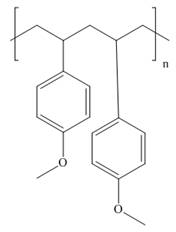
Explanation of Solution
The given alkene undergoes radical polymerization in presence of peroxide to form the
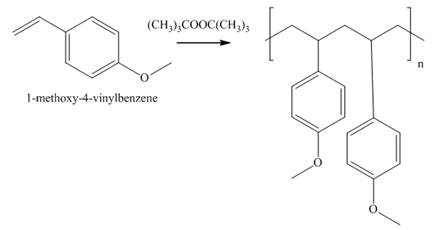
Figure 1
The product for the given reaction is shown in Figure 1.
(b)
Interpretation: The product for the given reaction is to be drawn.
Concept introduction: The reaction of an olefin with Ziegler-Natta catalyst leads to the formation of a linear and high molecular weight polymer. The components involved in Ziegler-Natta catalyst are
Answer to Problem 31.50P
The product for the given reaction is,

Explanation of Solution
The given alkene undergoes polymerization in presence of Ziegler-Natta to form the linear and high molecular weight polymer. The corresponding chemical reaction is shown below.

Figure 2
The product for the given reaction is shown in Figure 2.
(c)
Interpretation: The product for the given reaction is to be drawn.
Concept introduction: The anionic polymerization is a chain growth polymerization. Anionic polymerization takes place in alkene substituted with electron withdrawing groups and
Answer to Problem 31.50P
The product for the given reaction is,
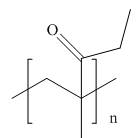
Explanation of Solution
The given alkene undergoes anionic polymerization in presence of

Figure 3
The product for the given reaction is shown in Figure 3.
(d)
Interpretation: The product for the given reaction is to be drawn.
Concept introduction: The cationic polymerization is a chain growth polymerization. This polymerization occurs in the alkenes with substituents which can stabilize the intermediate carbocation. This is an electrophilc addition reaction that involves the carbocations as intermediates.
Answer to Problem 31.50P
The product for the given reaction is,

Explanation of Solution
The given alkene undergoes cationic polymerization in presence of boron trifluoride in aqueous medium to form the polymer. The corresponding chemical reaction is shown below.

Figure 4
The product for the given reaction is shown in Figure 4.
(e)
Interpretation: The product for the given reaction is to be drawn.
Concept introduction: The anionic polymerization is a chain growth polymerization. Anionic polymerization takes place in alkene substituted with electron withdrawing groups and epoxides. In this polymerization the initiator is anion.
Answer to Problem 31.50P
The product for the given reaction is,
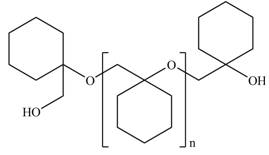
Explanation of Solution
The given epoxide undergoes anionic polymerization in presence base to form the polymer. The corresponding chemical reaction is shown below.
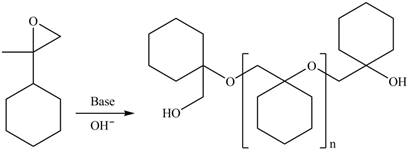
Figure 5
The product for the given reaction is shown in Figure 5.
(f)
Interpretation: The product for the given reaction is to be drawn.
Concept introduction: In Step-growth polymerization the monomers with different
Prepolymer which is composed of polymeric chain with epoxide rings at the each terminal and
Answer to Problem 31.50P
The product for the given reaction is,
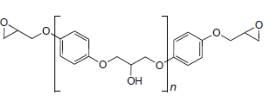
Explanation of Solution
The resorcinol undergoes step growth polymerization in presence of excess epichlorohydrin to form the polymer. The corresponding chemical reaction is shown below.

Figure 6
The product for the given reaction is shown in Figure 6.
(g)
Interpretation: The product for the given reaction is to be drawn.
Concept introduction: In Step-growth polymerization the monomers with different functional groups combine together to form the polymer with the loss of small molecule such as water. For example polyamides, polyesters, polyurethanes, polycarbonates and epoxy resins.
The polyesters are formed by the reaction of acid and alcohol as monomers.
Answer to Problem 31.50P
The product for the given reaction is,

Explanation of Solution
The given polyester on hydrolysis produces its monomers. The ester linkages are cleaved to produce alcohol and acid. The corresponding chemical reaction is shown below.
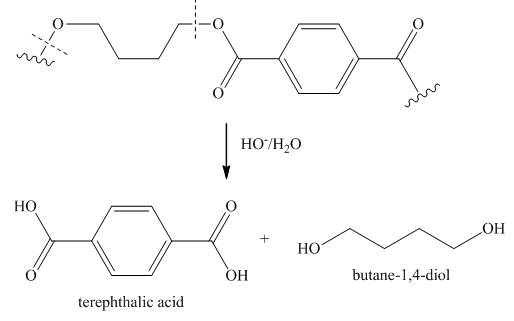
Figure 7
The product for the given reaction is shown in Figure 7.
(h)
Interpretation: The product for the given reaction is to be drawn.
Concept introduction: The reaction of monomer unit to produce a chain like or cyclic structure is known as polymerization. In some polymerization, ring formation takes place which are called ring-forming polymerization.
Answer to Problem 31.50P
The product for the given reaction is,
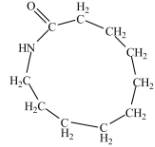
Explanation of Solution
The given compound reacts with base to form the cyclic polymer. The corresponding chemical reaction is shown below.

Figure 8
The product for the given reaction is shown in Figure 8.
(i)
Interpretation: The product for the given reaction is to be drawn.
Concept introduction: In Step-growth polymerization the monomers with different functional groups combine together to form the polymer with the loss of small molecule such as water. For example polyamides, polyesters, polyurethanes, polycarbonates and epoxy resins.
Polyurethanes contain carbonyl compounds bonded to
Answer to Problem 31.50P
The product for the given reaction is,
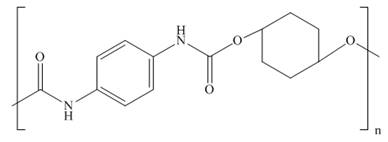
Explanation of Solution
The given diisocyanate reacts with the given

Figure 9
The product for the given reaction is shown in Figure 9.
(j)
Interpretation: The product for the given reaction is to be drawn.
Concept introduction: In Step-growth polymerization the monomers with different functional groups combine together to form the polymer with the loss of small molecule such as water. For example polyamides, polyesters, polyurethanes, polycarbonates and epoxy resins.
Polycarbonates contain carbonyl compounds bonded to two
Answer to Problem 31.50P
The product for the given reaction is,

Explanation of Solution
The given diol reacts with phosgene to undergo step growth polymerization to form the polycarbonate. The corresponding chemical reaction is shown below.
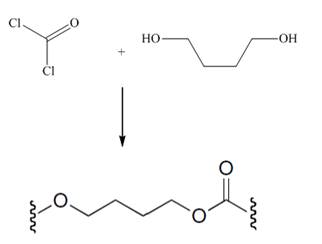
Figure 10
The product for the given reaction is shown in Figure 10.
Want to see more full solutions like this?
Chapter 31 Solutions
Organic Chemistry
- Identify and provide a concise explanation of a specific analytical instrument capable of detecting and quantifying trace compounds in food samples. Emphasise the instrumental capabilities relevant to trace compound analysis in the nominated food. Include the specific application name (eg: identification and quantification of mercury in salmon), outline a brief description of sample preparation procedures, and provide a summary of the obtained results from the analytical process.arrow_forwardIdentify and provide an explanation of what 'Seperation Science' is. Also describe its importance with the respect to the chemical analysis of food. Provide specific examples.arrow_forward5. Propose a Synthesis for the molecule below. You may use any starting materials containing 6 carbons or less (reagents that aren't incorporated into the final molecule such as PhзP do not count towards this total, and the starting material can have whatever non-carbon functional groups you want), and any of the reactions you have learned so far in organic chemistry I, II, and III. Your final answer should show each step separately, with intermediates and conditions clearly drawn. H3C CH3arrow_forward
- State the name and condensed formula of isooxazole obtained by reacting acetylacetone and hydroxylamine.arrow_forwardState the name and condensed formula of the isothiazole obtained by reacting acetylacetone and thiosemicarbazide.arrow_forwardProvide the semi-developed formula of isooxazole obtained by reacting acetylacetone and hydroxylamine.arrow_forward
- Given a 1,3-dicarbonyl compound (R1-CO-CH2-CO-R2), indicate the formula of the compound obtaineda) if I add hydroxylamine (NH2OH) to give an isooxazole.b) if I add thiosemicarbazide (NH2-CO-NH-NH2) to give an isothiazole.arrow_forwardAn orange laser has a wavelength of 610 nm. What is the energy of this light?arrow_forwardThe molar absorptivity of a protein in water at 280 nm can be estimated within ~5-10% from its content of the amino acids tyrosine and tryptophan and from the number of disulfide linkages (R-S-S-R) between cysteine residues: Ε280 nm (M-1 cm-1) ≈ 5500 nTrp + 1490 nTyr + 125 nS-S where nTrp is the number of tryptophans, nTyr is the number of tyrosines, and nS-S is the number of disulfide linkages. The protein human serum transferrin has 678 amino acids including 8 tryptophans, 26 tyrosines, and 19 disulfide linkages. The molecular mass of the most dominant for is 79550. Predict the molar absorptivity of transferrin. Predict the absorbance of a solution that’s 1.000 g/L transferrin in a 1.000-cm-pathlength cuvet. Estimate the g/L of a transferrin solution with an absorbance of 1.50 at 280 nm.arrow_forward
- In GC, what order will the following molecules elute from the column? CH3OCH3, CH3CH2OH, C3H8, C4H10arrow_forwardBeer’s Law is A = εbc, where A is absorbance, ε is the molar absorptivity (which is specific to the compound and wavelength in the measurement), and c is concentration. The absorbance of a 2.31 × 10-5 M solution of a compound is 0.822 at a wavelength of 266 nm in a 1.00-cm cell. Calculate the molar absorptivity at 266 nm.arrow_forwardHow to calculate % of unknown solution using line of best fit y=0.1227x + 0.0292 (y=2.244)arrow_forward
 ChemistryChemistryISBN:9781305957404Author:Steven S. Zumdahl, Susan A. Zumdahl, Donald J. DeCostePublisher:Cengage Learning
ChemistryChemistryISBN:9781305957404Author:Steven S. Zumdahl, Susan A. Zumdahl, Donald J. DeCostePublisher:Cengage Learning ChemistryChemistryISBN:9781259911156Author:Raymond Chang Dr., Jason Overby ProfessorPublisher:McGraw-Hill Education
ChemistryChemistryISBN:9781259911156Author:Raymond Chang Dr., Jason Overby ProfessorPublisher:McGraw-Hill Education Principles of Instrumental AnalysisChemistryISBN:9781305577213Author:Douglas A. Skoog, F. James Holler, Stanley R. CrouchPublisher:Cengage Learning
Principles of Instrumental AnalysisChemistryISBN:9781305577213Author:Douglas A. Skoog, F. James Holler, Stanley R. CrouchPublisher:Cengage Learning Organic ChemistryChemistryISBN:9780078021558Author:Janice Gorzynski Smith Dr.Publisher:McGraw-Hill Education
Organic ChemistryChemistryISBN:9780078021558Author:Janice Gorzynski Smith Dr.Publisher:McGraw-Hill Education Chemistry: Principles and ReactionsChemistryISBN:9781305079373Author:William L. Masterton, Cecile N. HurleyPublisher:Cengage Learning
Chemistry: Principles and ReactionsChemistryISBN:9781305079373Author:William L. Masterton, Cecile N. HurleyPublisher:Cengage Learning Elementary Principles of Chemical Processes, Bind...ChemistryISBN:9781118431221Author:Richard M. Felder, Ronald W. Rousseau, Lisa G. BullardPublisher:WILEY
Elementary Principles of Chemical Processes, Bind...ChemistryISBN:9781118431221Author:Richard M. Felder, Ronald W. Rousseau, Lisa G. BullardPublisher:WILEY





